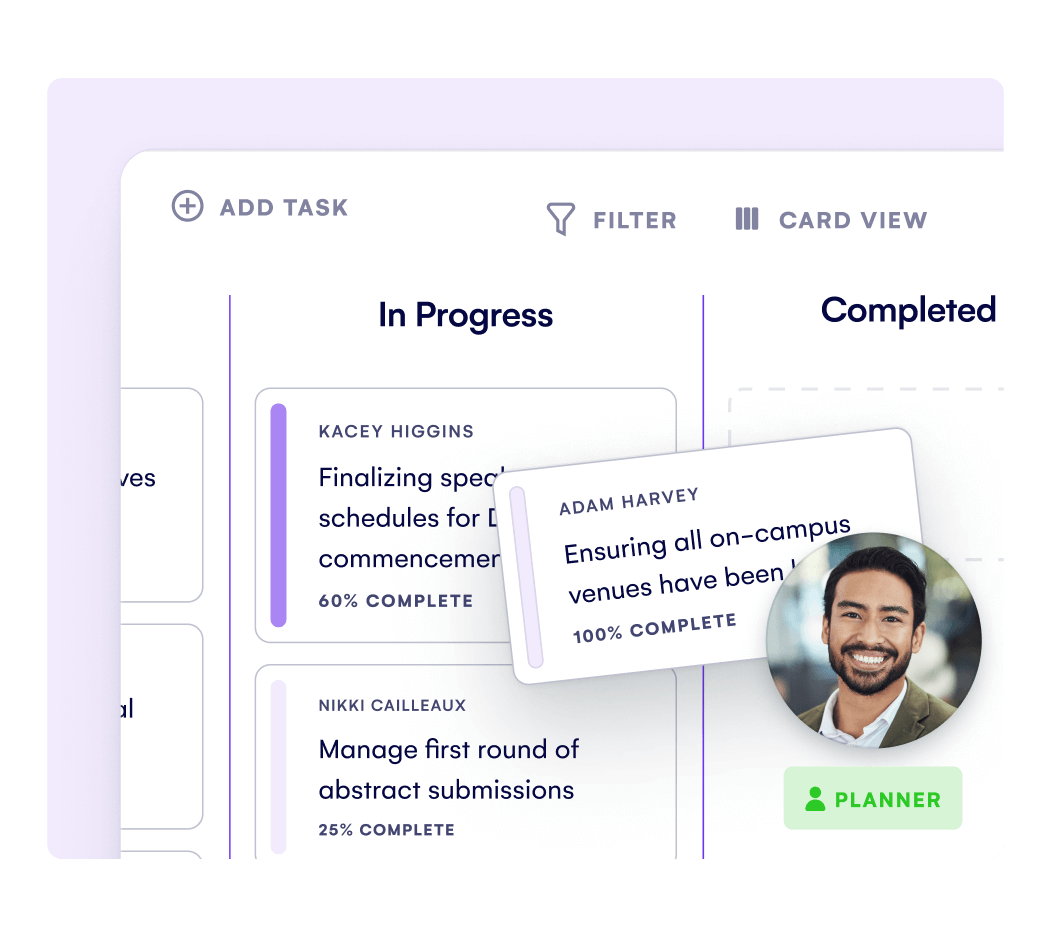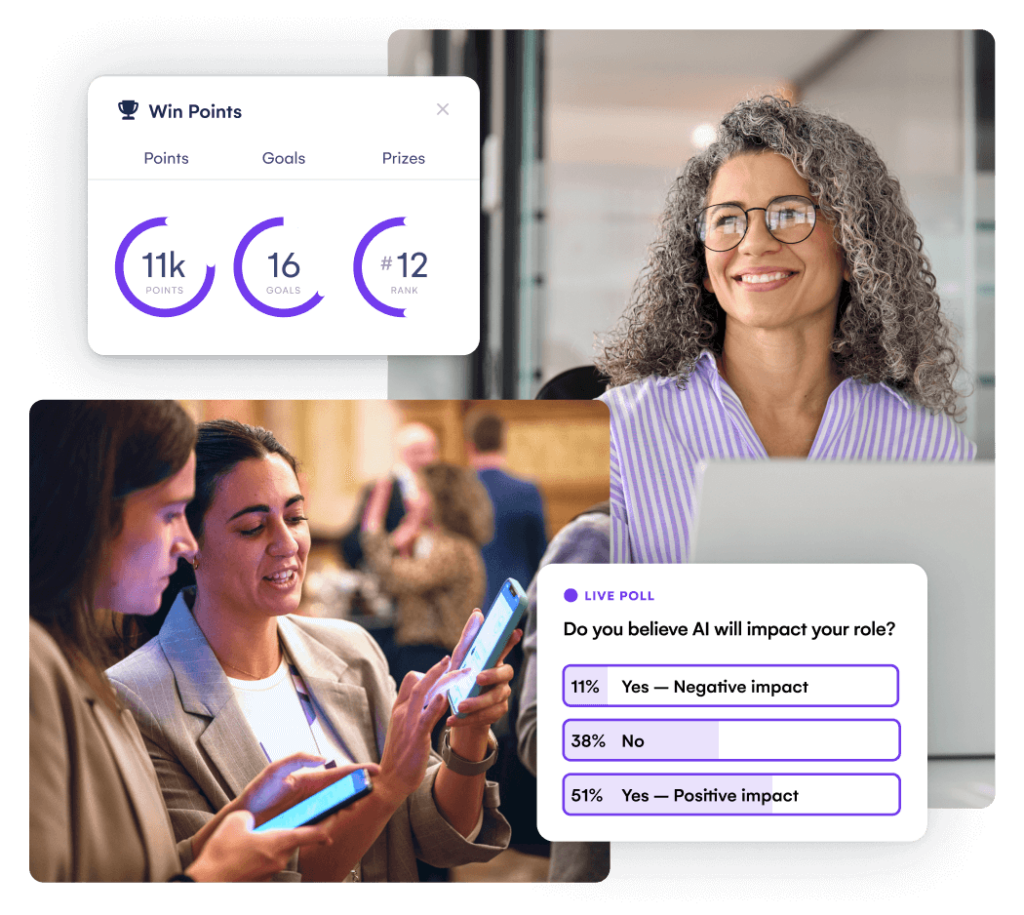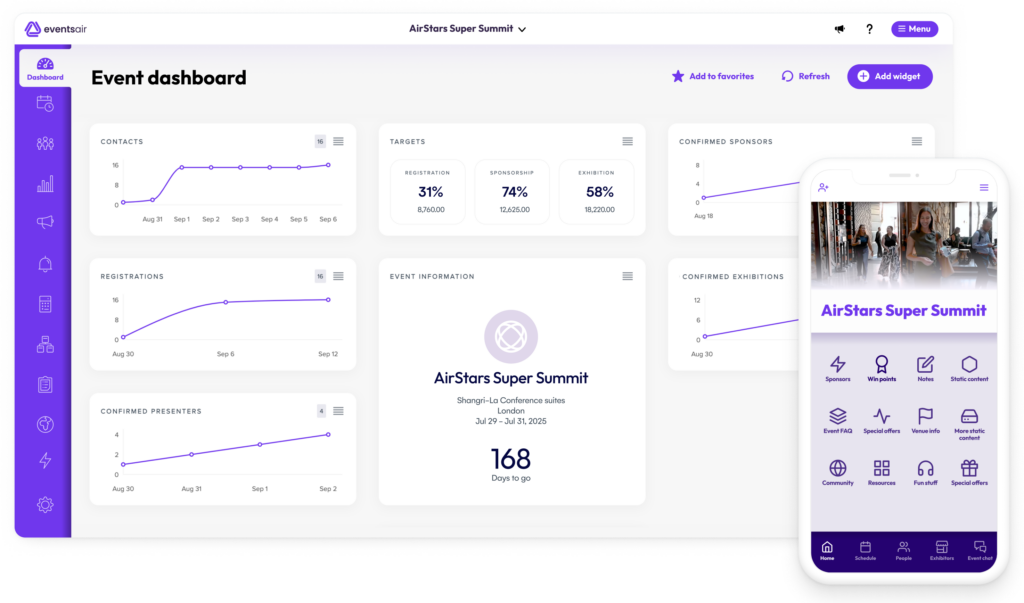We Break Down Event Planning Timelines (+ How to Build One)

Planning a successful event starts with a solid foundation – and that means creating an event planning timeline. Breaking the process into clear steps helps you stay organized and avoid any last-minute chaos.
With a good timeline, you’ll keep everything on track, whether it’s setting goals, building your team, booking vendors, coordinating speakers, or engaging attendees. Without one, deadlines sneak up, vendors get booked, and the stress can take over.
Fortunately, if you’re new to event planning or just looking for a simple, foolproof process, this EventsAir guide will walk you through the basics of an event planning timeline.
With the right plan in place, you’ll create a hybrid, virtual, or in-person event experience people will remember.
What is an event planning timeline?
An event planning timeline is your source of truth for organizing an event. It breaks down every step of the event planning process, helping you stay on track and get things done in the right order. Think of it as your roadmap, taking you from the first idea to the final post-event details.
More than just a checklist, an effective event planning timeline provides a clear structure for managing:
- Key milestones: From initial concept to post-event evaluation
- Task assignments: Defining responsibilities for team members and stakeholders
- Deadlines: Securing venues, vendors, and registrations on time
- Marketing and promotions: Scheduling event marketing campaigns to maximize attendance
Whether planning a corporate conference, a hybrid networking event, or a large-scale trade show, a timeline ensures that every detail is accounted for at the right time, keeping everything on track from start to finish.
Why do you need an event planning timeline?
Keeps everything on track
An event planning timeline ensures tasks are completed in the right order and on schedule. As an organizer, you can better manage deadlines, avoid last-minute scrambles, and maintain a smooth planning process.
Improves team coordination
With clear timelines and assigned responsibilities, your team can stay aligned and accountable. Everyone knows what they need to do and when, reducing miscommunication and ensuring seamless collaboration between vendors, speakers, event staff, and other stakeholders.
Prevents overlooked details
Without a structured plan, crucial details can easily slip through the cracks. However, with a well-designed planning timeline, you can ensure nothing is forgotten, from securing permits to finalizing catering and AV setups.
Enhances attendee experience
Proper planning also allows for a polished, well-executed event. When logistics run smoothly, guests experience seamless check-ins, engaging content, and an overall enjoyable event without noticeable hiccups.
Reduces stress and last-minute chaos
Knowing what needs to be done – and when – minimizes last-minute panic. A timeline allows you to anticipate potential issues, address them proactively, and approach event day with confidence.

Twelve-month event planning timeline you can adapt to your needs
Every event is different, but starting (at least) twelve months ahead gives you enough time to organize everything properly. This timeline helps you stay on top of key tasks, making sure nothing is rushed and your event runs smoothly. If your event is large (or complex) we recommend you starting this process even earlier – just so you have enough breathing room to plan with confidence.
Twelve months before: set goals and secure key details
The first step is laying the groundwork. This means deciding what you want to achieve, setting a budget, booking a venue, building your team, and finding sponsors and partners if needed.
Key tasks
- Define objectives: Clarify the event’s purpose (e.g., networking, fundraising) and align goals with your organizational needs.
- Set a budget: List expected costs (venue, food, speakers, marketing) and plan funding sources (ticket sales, sponsorships). Keep contingency funds.
- Choose a venue and date: Find and book a venue early to secure the best date, ensure accessibility, and confirm equipment needs.
- Build your event team: Assign roles and schedule regular check-ins.
- Secure sponsors: Identify potential sponsors, create partnership packages, and begin outreach by sending proposals.
- Lock in vendor details: Ensure all logistics and deliveries are on track.
This foundational work ensures everything is in place for a seamless planning process moving forward.
TIP: Check out our detailed guides on how to create a proposal here. We’ve also curated a host of event budget templates you can adapt for this step.
Six months before: confirm vendors and start promotions
With the foundation set, it’s time to start locking in key details. This includes booking vendors, reaching out to speakers, and launching your marketing efforts to get people interested in your event.
Key tasks
- Secure speakers: Contact potential guests early, confirm availability, and plan logistics.
- Launch marketing: Create an event page, schedule social media posts, and start email campaigns.
- Walk through venue: Confirm layouts, seating, and tech setups.
- Finalize sponsorships: Follow up on outreach, finalize agreements, and incorporate sponsor branding.
- Set up registration: Choose a platform, test for ease of use, and consider tiered ticket options.
By handling these key tasks now, you’ll have a solid event framework in place.
Three months before: focus on the attendee experience
With vendors and marketing in motion, it’s time to focus on what will make your event engaging and smooth for attendees. This includes finalizing the schedule, opening registration, and making sure logistics are coming together.
Key tasks
- Open registration: Test sign-up processes and track attendance.
- Finalize schedule: Confirm session times, speaker availability, and breaks.
- Enhance engagement: Plan Q&A sessions, networking areas, and interactive features.
- Arrange travel and accommodations: Secure plans for VIPs and provide attendee recommendations.
- Continue marketing: Expand advertising and promotional efforts with teasers and collaborations.
- Review security plans: Ensure emergency procedures and team assignments.
At this stage, your event should be taking shape, with most logistics falling into place.
Two months before: finalize logistics and tech setup
With the event getting closer, now is the time to finalize logistics and make sure all technical details are in place. This includes confirming vendor agreements, testing event platforms, and ramping up promotions.
Key tasks
- Confirm vendor arrangements: Double-check schedules, deliveries, and requirements.
- Test technology: Run trials for virtual and in-person AV setups.
- Prepare branding: Print signage, name tags, and promotional materials.
- Boost engagement: Send reminders, preview schedules, and onboard attendees to event apps.
- Check compliance: Verify permits, security, and accessibility needs.
By now, your event should be taking shape, with most of the logistics locked in.
One month before: review details and attendee communication
With two months to go, the focus shifts to fine-tuning logistics, finalizing attendee communication, and preparing for any last-minute adjustments. At this stage, you should be reviewing all event details, ensuring your team is aligned, and keeping attendees engaged.
Key tasks
- Walk through venue, again: Re-confirm layouts, seating, and tech setups.
- Prepare attendee emails: Send confirmations, travel tips, and event FAQs.
- Finalize speaker logistics: Confirm schedules, travel, and expectations.
- Ramp up promotions: Increase social media activity and drive last-minute sign-ups.
Everything should be coming together smoothly, with only a few final details left to refine.
Two weeks before: final preparations and rehearsals
With just one month to go, it’s time to fine-tune logistics, confirm final details, and conduct rehearsals to ensure everything runs smoothly. This is the last chance to address potential issues before event week.
Key tasks
- Send final reminders: Provide schedules, FAQs, and last-minute updates.
- Brief team and vendors: Confirm roles, responsibilities, and troubleshooting plans.
- Conduct tech rehearsals: Run soundchecks, virtual platform tests, and backup plans.
- Finalize materials: Print programs, badges, and branding elements.
- Confirm catering and logistics: Double-check meal preferences, security, and venue setups.
By this point, most of the heavy lifting is done, and you’re in the final stretch.

Event week: execute and adapt
With just days to go, your focus should be on final checks, smooth setup, and making sure your team is ready to handle any last-minute changes. This is the time to ensure all moving parts align so the event runs as planned.
Key tasks
- Oversee setup: Verify venue layout, AV, signage, and exhibitor spaces.
- Brief team: Assign troubleshooting roles and streamline communication.
- Manage check-ins: Test registration systems and assist attendees.
- Stay flexible: Adapt to unexpected changes with backup solutions.
- Capture content: Document key moments and encourage attendee engagement.
- Team wellbeing: Foster a culture of mutual support to navigate demanding workloads and prioritize collective wellbeing.
With careful execution and a proactive mindset, your event will unfold as planned.
After the event: wrap up and measure success
The event is over, but the work isn’t done yet. Now is the time for post-event analysis, where you gather feedback, analyze results, and follow up with attendees, speakers, and sponsors to maximize the impact of your event.
Key tasks
- Collect feedback: Send surveys to attendees, speakers, and sponsors.
- Analyze performance: Assess attendance, engagement, and ROI.
- Follow up: Send thank-you emails and share event highlights.
- Organize materials: Archive photos, presentations, and key takeaways.
- Continue the conversation: Discover creative ways to repurpose your recorded content and reconnect with attendees. It’s a great way to maintain momentum as you build up to your next big event.
A well-executed post-event wrap-up ensures lasting impact and helps you continuously improve for the future. With these steps completed, you’re not just wrapping up this event—you’re setting the stage for even bigger successes ahead.
TIP: Check our guide on how to conduct an effective post-event analysis here.
Simplify event planning with EventsAir
Planning an event involves managing countless details, from budgeting and registration to attendee engagement and post-event analysis. Fortunately, EventsAir streamlines the entire process, helping you stay organized and on schedule with powerful automation and intuitive tools.

With our all-in-one events management platform, you can:
- Keep planning on track using task lists, budget forecasting, and workflow automation
- Manage registrations effectively by setting up ticketing, payment processing, and custom attendee paths.
- Simplify execution by managing check-ins, control session access, and manage real-time logistics.
- Analyze post-event success by gathering insights, generating reports, and maximizing feature event’s ROI.
From start to finish, EventsAir keeps every stage of your event timeline running smoothly. We’ve powered over 350,000 events worldwide, including events hosted by Microsoft, MCI, ICCA, MICE Concierge, and more.
Book a demo today to see it in action.



